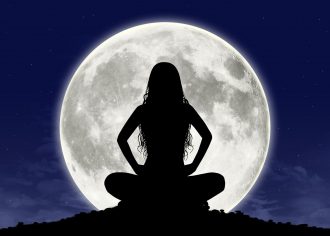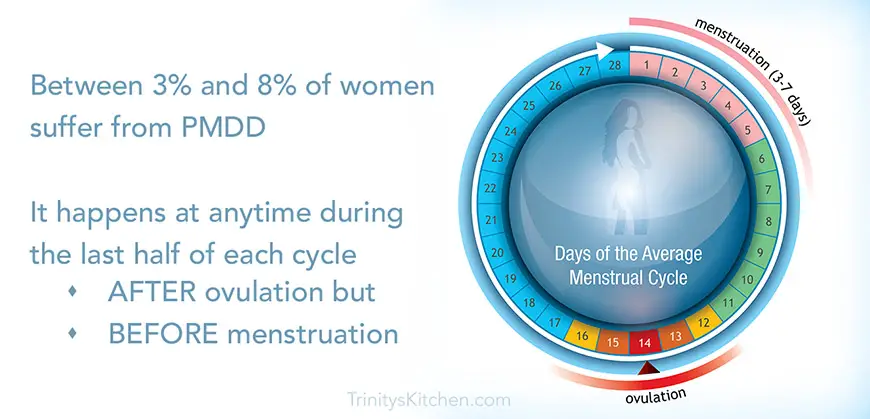Contributing writer for Wake Up World
If you are challenged or have someone close to you who suffers from Premenstrual Syndrome/Tension (PMS/PMT) or Premenstrual Dysphoric Disorder (PMDD), then this article is for you. Our modern society has largely lost touch with the original and sacred nature of the female cycle, which in turn has an enormous effect on a significant proportion of women. I will briefly touch on where things have gone wrong in our culture to harm the female cycle, what PMDD is, and ways that you can treat premenstrual challenges naturally by embracing the ‘whole’, beautiful woman that you truly are.
The female cycle was meant to be a sacred gift.
I’d like to start by saying that many moons ago, the female menstrual cycle was – believe it or not – celebrated as a gift of fertility and femininity, as our rhythm naturally aligned with the waxing and waning of the moon. Shedding of menstrual ‘blood’ was considered a special time for rest, purification and rejuvenation. Various cultures including Native American, Aborigine, Druid and African, regarded a menstruating woman to be incredibly sacred – blessed with a gift to heal, protect or to bridge into the higher realms of awareness. Some cultures and individuals still do honour this, although much of the knowledge has been suppressed, distorted and lost. During this phase, a woman is endowed with phenomenal power of the divine feminine. Denying this sacred rite, has had an enormous domino effect on women, including modern day pre-menstrual disorders.
[pro_ad_display_adzone id=”110028″]
Redefining the ‘period’:
Personally, I don’t like the name ‘period’. It’s sounds like a prison sentence to me, with harsh and negative associations for many women. It can help to move away from that name towards something more gentle, yin and nurturing. Many women (myself included) choose the word “Moontime”, in honour of the cyclical nature of the monthly cycle and it’s natural yearning to realign with the cycles of the moon. Renaming the menstrual phase can have a beautifully healing effect (you may, on the other hand, feel fine with the name, it’s different for all of us.)
The unbearable pressure cooker:
Sadly, the monthly cycle has become a taboo subject, even in our modern, supposedly open-minded world. Our society encourages it to be hidden, and heaven forbid, if you don’t keep it under total control, no matter what activities you have to participate in. In today’s world, women are not given the time and space to honour the cycle. If they take time off work, they are usually considered weak; if they take time to rest, they are often seen as lazy. Pre-menstrual symptoms carry incredible stigma and are often misunderstood. The distress on the mind, body and spirit by not honouring the cycle, generates a knock-on, unbalanced effect of physical and hormone related emotional issues that shouldn’t even exist. It creates a pressure cooker that just has to explode sooner or later.
PMDD is premenstruation at its most challenging.
We’ve all heard of PMS. It is estimated up to 80% of women suffer from Premenstrual Syndrome (PMS). This might include anything from headaches, emotional sensitivity, breast tenderness, pains, fatigue, frustration or anger. A woman is normally able to carry on with daily tasks, although it can be a bit of a slog. PMDD however, is much more severe and less known about, so I am going to give an overview before we move on to the 21 ways to treat these challenges.
PMDD is in a league of its own (effecting between 3 and 8% of women during their reproductive years). It is characterised by a worsening of mood that can seriously inhibit a woman’s ability to function during the last 7 – 14 days (the leuteal phase) of the menstruation cycle. PMDD is thought to involve a malfunction of chemistry in the brain, that coincides with the hormonal shifts caused by ovulation. Symptoms may be worsened by a imbalance of estrogen and progesterone levels, causing a serotonin deficiency.
I suffered with PMDD for most of my adult life, so I understand the devastating impact that it can have on all levels. It was only when I acknowledged it and took it into my own hands that I managed to ‘control’ it. This malfunction can have a catastrophic impact on work, relationships and well-being. It is cyclical in nature, only showing during the premenstrual phase of the cycle – completely disappearing shortly after a woman begins to menstruate. If you experience the symptoms of PMDD all month long, it is something different.
How can you tell if you have PMDD?
A woman with PMDD may experience several or all of the following symptoms after ovulation has happened in the cycle:
- feeling overwhelmed by ordinary things
- persistent feelings of anger or irritability
- feeling out of control
- depression
- suicidal thoughts
- debilitating tiredness
- panic attacks
- anxiety
- difficulty focusing
- insomnia or too much sleeping
- total lack of interest in favourite things
- feelings of going crazy
- massive cravings for carbs/sugars
The roller coaster plunge into hell:
It is cyclical in nature, and can be like a roller coaster plunge into the depths of hell. You might even see it coming, yet hope that it won’t manifest. Personally, I am normally a very positive, vibrant and motivated character. It brings me great joy to share my light with others. Yet, during every cycle, I used to watch the process beginning to take hold. For me, it was like being injected with a mind altering drug, a poison that floods every cell. It set off a chain-reaction into process that, once it is allowed to really take hold, made me feel unable to bear life and lose motivation for everything. I couldn’t concentrate, I got angry, I felt illogical and reacted emotionally to the smallest of things. Worst of all, I sometimes even lost the will to live.
I feel that it is about time I reached out to all of those other women who suffer and say – I see you – I understand – I know exactly how it feels. And if you really want, you can do something about it. I want to reach out and say there IS a way through this naturally, and if I can climb from the deepest depths of PMDD hell – then so can you!
Preparation ahead of time is essential.
When you are in the depths of suffering, the last thing you usually want to do, is help yourself. You are much more likely to want to curl into a ball and die. Motivation usually disappears. The key is preparation ahead of time. Remember, there will be at least two weeks in any given cycle where you are up, or at least not having to battle a hormonal dysfunction. During your ‘up-time’, you need to be thinking ahead, so that once you start to slip, you can do something about it. Most women find that once it passes a certain threshold, it’s almost impossible to do anything about it.
[pro_ad_display_adzone id=”110030″]
The key is not letting it get that far. You need to look after your health, sleep well, eat well, exercise well all month long, so that you are more able to cope when you start to fall. You need to find a rhythm of things that nurture you… a rhythm will make it easier to do those things when you start losing motivation.
The best ‘cure’ is prevention. It’s about empowering your self to consistently take steps ahead of time. Once PMDD is in full throttle, it can feel like being tossed and turned about in a tsunami, in which case, it’s nigh-on impossible to get yourself out of it, until the cycle runs itself through. The key is not letting it get that far!
When I find a rhythm, in my up-time, I make a commitment to myself that no matter what – even if I have to do it against my will – I will do these things (listed below) when I am at my lowest point, when I find it unbearable. That commitment sometimes feels like a matter of life or death. An example is to make a point of going on a brisk country walk for at least a half hour every day. This is a great way to connect with nature and stay fit. I find that when I am beginning to suffer, I really don’t want to do go for a walk – BUT because it is a normal part of my usual rhythm, it is much easier to give myself a push to do it anyway. And I always feel much better for it. It stimulates endorphins, helps to keep my energy moving, flushing out things that make my system feel worse.
I’ve learned that if (and only if) I take certain natural measures to really take care of myself, then this disorder becomes manageable. It’s up to us though, we have to step into our female power and take action.
21 ways to treat PMS and PMDD, naturally!
I’ve found some invaluable things that help me re-balance energies in the pre-menstrual phase of moontime. We are all unique, so find what works for you…
1. Eating healthy: It’s essential to eat a wholefoods diet, eliminating caffeine, dairy, wheat, refined sugar and junk foods as much as you possibly can. If you are sensitive to wheat, gluten or other foods, then it could be inhibiting your ability to absorb nutrients, which will worsen any menstrual condition. Eating a healthy diet as a way of life (like the one I recommend at Trinity’s Kitchen) will give you a great foundation from which to reclaim the beautiful and divine woman that you are. It’s one of the most effective ways that you can love yourself.
2. Juicing: I’ve found that staring my days with a fresh, organic vegetable juice on the run-up to my menstrual phase, seriously lessens my symptoms. In conjunction with exercise, clean eating and rest, it can almost eradicate my PMDD symptoms entirely! I don’t exactly know why this happens, although I suspect that the juice allows for a rapid infusion of top quality nutrients that support brain chemistry and hormonal stabilisation. Here’s a recipe I created with energy balancing in mind: Woman’s Wellness Juice
3. Agnus Castus (Chaste Berry/Vitex Agnus Castus) herb: To me, this feels like ‘nirvana’. The tincture works quickly if you already eat a healthy diet. It is the first thing I used to reach for when it all got too much. It contains compounds which are able to adjust the production of female hormones. Studies have shown that extracts of Agnus castus can stimulate the release of Leutenizing Hormone (LH) and inhibit the release of Follicle Stimulating Hormone (FSH), which in simple terms, suggests that it has a progesterone-like effect. Its benefits partially stem from its actions upon the pituitary gland, specifically on the production of LH. This may increase progesterone and helps regulate a woman’s cycle. In addition, it is thought to be able to normalize the secretion of many hormones, for instance, reducing prolactin levels and normalizing the estrogen to progesterone ratio. I prefer to take it in tincture form, because it seems to be effective much quicker.
4. B vitamins: We use up a lot of B vitamins when we are stressed, so if we are prone to anxiety and stress during the premenstrual phase, then it’s really helpful to replace them by taking a good quality supplement. B6 is has particularly noteworthy benefits. It is said to increase production of the neurotransmitters serotonin and dopamine. Low levels of these neurotransmitters is one of the main causes of the symptoms associated with PMDD. Here is the B complex that I take here in England (it also contains adaptogenic herbs like rhodiola, siberian ginseng and ashwagandha to help maintain balance when it gets challenging): Terranova B Complex
5. Maca: This the root of a South American plant and comes in powdered form. It has all sorts of properties, although the thing that stands out for me, is that it’s an ‘adaptogen’, which means it helps the body adapt and find balance in stressful situations. I say that it is probably the jewel in the crown for hormonal support for me. Taking a teaspoon daily over a period of time has literally changed my life. This is the one thing that I just couldn’t live without. A lovely friend of mine also said it worked for her (and she knew this, because she told me jokingly, after adding it to her smoothies daily, ‘it was the first month she hadn’t felt like killing someone!’…). I find gelatanized maca easier to digest and assimilate than raw maca. Here is a popular article that I wrote all about Maca: All About Maca, Health Benefits and Delicious Recipes
6. Kava Kava herb: This is an excellent anti-anxiety herb. It helps us find a space of calm and peace within, when all else fails. I’ve been using this on and off for about 20 years. It has been used successfully in Polynesian Pacific Islands for centuries. I don’t take it all of the time. I like to switch and change the herbs I use (except for maca which is fairly constant for me). It’s well worth looking into different options that help us to naturally re-balance, although I would say that one of the most important things is to take time to replenish and rest. I must warn you though, it has had a unfortunate, controversial ban in several European countries, based on what many consider incomplete evidence. It can be purchased in the rest of the world easily though. It’s a personal choice. You can easily purchase it in a good health food store in most countries or find it online here: Gaia Herbs Kava Kava Root Extract Ticture
7. Pro-biotics: Be sure to keep your intestinal flora healthy. A healthy gut is key in metabolising and clearing toxins and even excess estrogen from your system.
8. Exercise: Exercise gets endorphins flowing and helps to flush out the excessive hormones or toxins and naturally re-aligns energies. Try brisk walking, yoga, pilates, rebounding, martial arts, swimming – whatever you feel pulled to – just be sure to get your energy moving. If you are in the thick of depression, then exercise is probably the last thing you want to do. It’s essential therefore, to get into a rhythm of daily exercise during the up-time of the rest of your cycle. This in itself will help lessen your symptoms. It will also mean that you are more likely to exercise before it gets so bad that all you want to do is curl up into a ball. If you are in the depths of despair, try doing something really gentle, like a walk on grass, or very soft swaying and movement (with loving music if you can). Swaying will also help to generate endorphins and induce calm.
9. Meditation: Meditation doesn’t have to be mystical or complicated. Sitting quietly and focusing on big, deep exhales and inhales can feel cleansing and nurturing. If you have the inclination, then go for a full-on, guided relaxation and unwinding meditation in the privacy of your own home. I am fortunate enough to be a meditation guide as one of my vocations in life – you can check out one of my deeply relaxing audio meditation to facilitate peace and calm here: Relax and Unwind Meditation
10. Loving ourselves: Strangely this is often the hardest thing for women to do (including myself). Take the time to stop and do something, like having a soak in the bath with essential oils, baking a deliciously healthy treat etc. It doesn’t matter how you feel about yourself, you are totally and utterly worth it, and deserve it! Loving yourself stimulates feel good chemicals, which lessens the severity of PMDD and other premenstrual challenges.
11. Reduce EMF exposure: I’ve noticed that reducing EMF (Electromagnetic Field) exposure makes a big difference for me. I spend quite a lot of my time using a screen, i.e. responding to emails, managing event bookings, doing design work or editing video. Although I don’t use WiFi myself (when connecting to the web I use an old fashion ethernet cable), my office does receive WiFi interference from several other buildings. This sort of interference does not support the flow of clear energy in our bodies. It hinders the natural, healthy, electrical impulses we have. I feel it like buzzing in my field. I notice how going out into nature or being barefoot on the grass, counteracts this. I do sleep in an EMF free zone, free from WiFi… this is remarkably rejuvenating and supportive. Make a conscious effort to find ways to connect with nature and get yourself away from EMF whenever possible, especially during your vulnerable times.
12. Self forgiveness: If you suffer from PMDD or have other serious premenstrual challenges, then it is highly likely that you have a low opinion of yourself during the imbalance and as part of the aftermath. If you get wildly angry, then it’s likely that you’ll regret it later. You may even hate yourself because you freaked out or feel like a failure because you can’t control your emotions. One of the most important things that you need to learn to do, is forgive yourself. It’s impossible to move on unless you make a commitment to forgive yourself. Self forgiveness is not about denial and shoving the issue under the rug. It’s about acceptance and surrender and knowing that it is your power to move forwards. It works something like this:
I accept that I was wildly emotional/angry/overwhelmed. I accept that I am not perfect. I am doing the best I can, no matter how challenging it is and how many times I fall.I forgive myself, because the most powerful way to heal myself is to forgive myself and keep working at this imbalance. I am committed to finding ever greater levels of balance and harmony, one step at a time. I accept that things won’t necessarily change overnight. I accept that whenever I fall, it’s OK to stand back up and start again, with every new moment. I forgive myself because no matter what my flaws are, holding onto self-judgement will never help me heal. I forgive myself because it is not my job to be perfect – it is my job to do the best I can.
13. Light therapy: I recently found compelling evidence that light therapy can help against serious premenstrual disorders like PMDD. I’d heard lots about it for Seasonal Affective Disorder (SAD), so I am familiar with the concept of having a lamp that mimics natural light. Daylight is known to stimulate hormones that promote a sense of well-being and good mood. If you don’t spend a lot of time outdoors or it’s quite dark outside a lot of the time, then a light box or lamp may help a lot.
14. Carbohydrates: Eating frequent, small portions of carbohydrate-rich foods may improve symptoms. This is thought to happen by increasing tryptophan levels (a precursor to serotonin). There are different schools of thought on this one. I just thought I’d cast it in as a possible support. I am certainly drawn to more carbohydrate rich foods, like potatoes, during my pre-moontime phase.
15. Vitamin D: The sunshine vitamin is known to play important roles in your body, including promoting serotonin production. Get plenty of sunshine during the sunny months and consider supplementing, especially during the darker times of the year. It may also be beneficial for some to supplement with vitamin D all year round.
16. Massage: This can significantly increase your serotonin, dopamine and endorphin levels, which are all beneficial to counteract the psychological symptoms of menstrual challenges. I’ve found that this can significantly lessen the symptoms for me personally. I believe this is due to the powerful role that serotonin plays to stabilise mood; that dopamine plays in encouraging feelings of joy; and that endorphins play in our ‘feel-good’ factor. If you are lucky enough to have someone around you that understands your situation, perhaps they’d be happy to give you a massage during your darkest moments. It can make the world of difference. If you have a regular cycle, then schedule in a massage with a therapist that you resonate with, a couple of days before your most vulnerable time. Alternatively, if you start feeling the depths of despair creeping in, schedule an impromptu massage treatment as soon as possible. Even if you have to wait a day or two for that session, just knowing that have one on its way can be like a rock in the storm.
17. Think happy thoughts: That may sound hilarious if you feeling like jumping off a ledge (as you may well do if you suffer from the more serious PMDD). I know, bear with me here. Focusing on positive things increases your serotonin levels. This is why laughter and joy are such a powerful healers. When your serotonin levels are low, happy thoughts are probably the last thing on your mind, so, it helps to make commitment to this before you a feeling at rock bottom. Or if you a lucky enough to have a supportive loved one, then ask them ahead of time to help you out with this. Have some things to hand that you can just pull out that make you think happy thoughts: like photos of a life changing holiday or really special cat piccies. Create a scrapbook full of inspiring images, a book with inspiration quotes or something that makes you smile. You can also create a YouTube play list of inspiring video clips or watch your favourite, uplifting movie or listen music that really motivates you. These all create a positive chemical influence on the body. I admit that this works better as a preventative, before you hit rock bottom.
18. Make a monthly chart: If you can see and predict when your most challenging times may be then you’ll be more likely to prepare ahead of time. Seeing it on a chart will also reassure you that it is a part of your monthly cycle and that you aren’t going crazy.
19. Get good quality sleep: This might sound a bit obvious, but worth a reminder. Sleep is essential for a healthy functioning body. It helps the body to detoxify itself, both physically and emotionally.
20. Raw vegan chocolate: One of the exceptions to eliminating caffeine is raw vegan, healthy chocolate. Cacao has been shown to help elevate the mood. It also contains serotonin, which is a natural anti-depressant. I can certainly confirm this one and use conscious chocolate for therapeutic purposes, especially in the 2nd half of my cycle. Check out my video for making your own, super-healthy, raw chocolate here: Homemade Healthy Chocolate Making Guide
21. Spend time in nature: The pulse of nature is really healing. Spending time to connect with the pulse of Mother Earth, in the forest, on the beach, by a river, in the sea. This all helps to realign our flow, back to how it was always designed to be.
I hope that you’ve found something here that resonates and can support your journey. This list is based on my own experiences and is not conclusive. If you have found other ways that help, please do share – I am always happy to look into new ways to help others.
If you know anyone who might benefit from this article, please do pass it on.
With love,
Trinity
Helpful resources:
- Chaste tree (Vitex agnus-castus)–pharmacology and clinical indications: www.ncbi.nlm.nih.gov/pubmed/12809367
- Light therapy for LLPDD: www.ncbi.nlm.nih.gov/pubmed/10482337
- Neurohormonal effects of massage therapy: www.pacificcollege.edu/…/neurohormonal-effects-massage-therapy
- The psychological, physiological and therapeutic effects of meditation: www.researchgate.net/…/analysis_of_recent_meditation_research
About the author:
Trinity is an experienced, empathic energy worker and the author of ‘Trinity’s Conscious Kitchen’ and ‘Angelicious’, recipe books designed to inspire the soul through conscious vegan, wheat-free & gluten-free cuisine.
22 years ago Trinity had a profound spiritual awakening that interconnected her with the deeper consciousness of life. What followed was a journey of compassion for all sentient beings, and a passion to share conscious eating for the benefit of all. Understanding that the energy of our food directly impacts sentient life on all levels, Trinity founded Trinity’s Conscious Kitchen, a website devoted to inspiring the soul through conscious, plant-based cuisine. She is also the co-founder of Openhand, an organisation dedicated to the conscious evolution of humankind, working as the divine complement to her soul mate Open. She is an integral part of the Openhand core team, supporting with the spiritual philosophy development, energy processing, publication of book and film, and is the Openhand retreat chef.
For more, please visit trinityskitchen.com, or follow Trinity’s Kitchen on Pinterest and Facebook.
Recommended articles by Trinity Bourne:
- 10 Reasons Why We all Should be Eating Ginger – Recipes Included
- Recipe: Green Superfood Smoothie Jam Packed with Health Benefits
- Top Tips for Making Deliciously Healthy Salads
- No-Bake Carrot Cake Recipe (Gluten Free & Vegan)
- The Importance of Eating Seeds for a Healthy Diet – Tips, Benefits & Recipes
- Foraging Guide – with 12 Nutritious Wild Plants That Anyone Can Find
- Keeping Slugs & Snails Off Your Veggies – Compassionately
- Chocolate Paradise Coconut Bar Recipe – Vegan, Raw, Absolutely Delicious!
- The Superfood Health Benefits of Celery (with Recipes!)
- Chocolate Covered Coconut Bliss Bars (Vegan, Gluten-Free, No-Bake)
[pro_ad_display_adzone id=”110027″]










